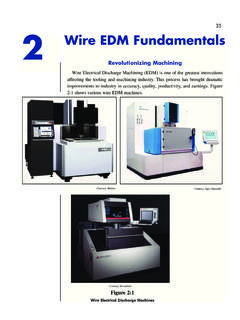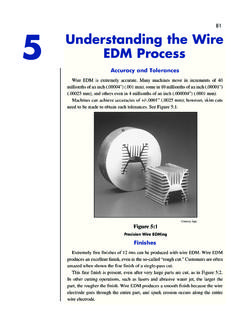Transcription of 9 Fundamentals of Ram EDM - Reliable EDM
1 137. 9 Fundamentals of Ram EDM. Ram EDM Machining Ram electrical discharge machining (EDM) also known as conventional EDM, sinker EDM, die sinker, vertical EDM, and plunge EDM, is generally used to produce blind cavities. See various machines in Figures 9:1. Courtesy Mitsubishi Figure 9:1. Ram Electrical Discharge Machines Complete EDM Handbook 138 Compliments of When a blind cavity is required, a formed electrode is machined to the desired shape. Then, by means of electrical current, the formed electrode that is surrounded by dielectric oil reproduces its shape in the workpiece.
2 See Figure 9:2. Courtesy Mitsubishi Figure 9:2. Ram EDM process uses a formed electrode to remove material. Ram EDM Beginnings Lightning is a form of electrical discharge machining. Its effect can be seen when it strikes the earth. Also, when a screwdriver shorts between a car body and battery, one witnesses how electricity can remove metal. In 1889, Benjamin Chew Tilghman, of Philadelphia, PA, received a patent (patent No. 416,873) entitled, Cutting Metal By Electricity." This is a portion of the patent: My object is to provide a method by which metal objects can not only be severed, but also planed, turned, or shaped in any ordinary way; and I avoid as far as possible heating the metal under treatment except at the point where the cutting action is taking place.
3 This I accomplish by concentrating the electric current upon a path or continuous series of small spots or points adjoining each other, and successively brought under the influence of the current, so that the metal is always heated to the desired degree at the point where it is being operated upon and not elsewhere. Although Tilghman had developed the concept of electrical discharge machining, spark erosion devices between World War I and World War II were used primarily to remove broken drills and taps. These early machines were very inefficient and difficult to use.
4 Fundamentals of Ram EDM 139. Then, two Russian scientists, Boris R. and Natalie I. Lazarenko (husband and wife) made two important improvements. First, they developed the R-C relaxation circuit which provided a consistent pulse control. Second, they developed a servo control unit which maintained a consistent gap allowing efficient electrical discharges. These two developments made ram EDM a more dependable means of machining. However, the process still had its limitations. For instance, the vacuum tubes used for the direct current circuit could not carry enough current or allow quick switches between on and off times.
5 Current and switching problems faded with the introduction of the transistor. Better accuracy and finishes resulted because the solid state device permitted the use of the proper current and switching for on and off.". Today's ram EDM machines have enhanced servo systems, CNC-controls with fuzzy logic, automatic tool changers (Figure 9:3), and capabilities of simultaneous six-axes machining. Ram EDM, along with wire EDM, has revolutionized machining. Courtesy Agie Figure 9:3. A CNC Ram EDM with Tool Changer Complete EDM Handbook 140 Compliments of How Ram EDM Works Ram EDM uses spark erosion to remove metal.
6 Its power supply generates electrical impulses between the workpiece and the electrode. A small gap between the electrode and the workpiece allows a flow of dielectric oil. When sufficient voltage is applied, the dielectric oil ionizes and controlled sparks melt and vaporize the workpiece. The pressurized dielectric oil cools the vaporized metal and removes the eroded material from the gap. A filter system cleans the suspended particles from the dielectric oil. The oil goes through a chiller to remove the generated heat from the spark erosion process. This chiller keeps the oil at a constant temperature which aids in machining accuracy.
7 See Figure 9:4. Servo Mechanism Ram Head Electrode Workpiece Power Dielectric Fluid Supply Dielectric Oil Reservoir Pump Filter Figure 9:4. The Ram EDM Process Fundamentals of Ram EDM 141. Ram EDM, like wire EDM, is a spark erosion process. However, ram EDM. produces the sparks along the surface of a formed electrode, as in Figure 9:5. Formed electrode: A servo controls the gap between the electrode and the workpiece. Sparks Occur Across Formed Electrode Workpiece Spark Erosion Figure 9:5. Spark Erosion Across the Formed Electrode A servo mechanism maintains the gap between the electrode and the workpiece.
8 The servo system prevents the electrode from touching the workpiece. If the electrode were to touch the workpiece, it would create a short circuit and no cutting would occur. The Step-by-Step Ram EDM Process The power supply provides electric current to the electrode and the workpiece. (A positive or negative charge is applied depending upon the desired cutting conditions.) The gap between the electrode and the workpiece is surrounded with dielectric oil. The oil acts as an insulator which allows sufficient current to develop. See Figure 9:6. A Positive 0r Negative Charge Is Applied to Electrode Dielectric Fluid Acts as an Insulator when Electricity Is Applied Power Supply A Negative or Positive Charge Is Applied to Workpiece Figure 9:6.
9 Power Supply Provides Volts and Amps Complete EDM Handbook 142 Compliments of Once sufficient electricity is applied to the electrode and the workpiece, the insulating properties of the dielectric oil break down, as shown in Figure 9:7. A plasma zone is quickly formed which reaches temperatures up to 14,500 to 22,000 F (8,000 to 12,000 C). The heat causes the fluid to ionize and allows sparks of sufficient intensity to melt and vaporize the material. This takes place during the controlled on time phase of the power supply. Electrode Dielectric Oil The dielectric oil acts as an insulator until sufficient voltage breaks down the resistance.
10 The oil ionizes and sparks occurs which melts or vaporizes the material. Workpiece Figure 9:7. Sparks Causes the Material to Melt and Vaporize During the off times," the dielectric oil cools the vaporized material while the pressurized oil removes the EDM chips, as shown in Figure 9:8. The amount of electricity during the on time determines the depth of the workpiece erosion. Pressurized Dielectric Oil Removes Edm Chips Dielectric Oil During Off Time Cools Vaporized Material Controlled Erosion Takes Place in Workpiece Figure 9:8. Pressurized Dielectric Oil Removes the EDM Chips Fundamentals of Ram EDM 143.



